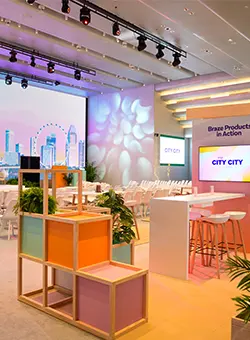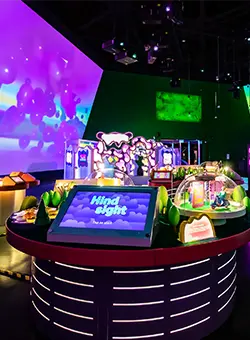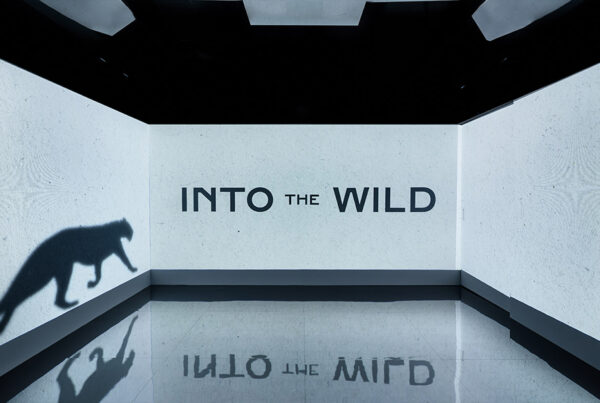In the ever-evolving world of modern marketing, where every brand vies for a moment of consumers’ fleeting attention, the challenge of captivating hearts and minds has reached new heights. Amid the competition, experiential marketing has emerged as a dynamic approach that transcends traditional advertising. It is not just any marketing strategy; it involves crafting immersive, participatory, and unforgettable experiences that resonate deeply with audiences.
At its core, experiential marketing possesses the power to etch a brand’s message and values into the memories of participants, fostering lasting connections that go far beyond a simple transaction.
Keep reading to delve into the key components underpinning unforgettable experiences within Singapore’s experiential marketing campaigns.
Part 2 – Experiential Marketing 101: Insights and Strategies for Impactful Experiences
2.1 Understanding the Essence of Memorable Experiences
Remarkable experiences imprint themselves upon participants’ memories, forging connections that withstand the test of time. Here are the foundational elements that infuse experiential marketing with this allure:
Emotional Connection
At the heart of creating lasting impressions lies the ability to forge emotional connections. By eliciting positive emotions like joy, excitement, or awe, a profound bond between participants and your brand can be cultivated to enhance memory formation and the overall experience. For instance, incorporating compelling storytelling techniques into a brand activation campaign that resonates with participants’ values and aspirations allows for the creation of narratives that stand the test of time. When brands evoke emotions, they create connections that go beyond the transactional nature of business.
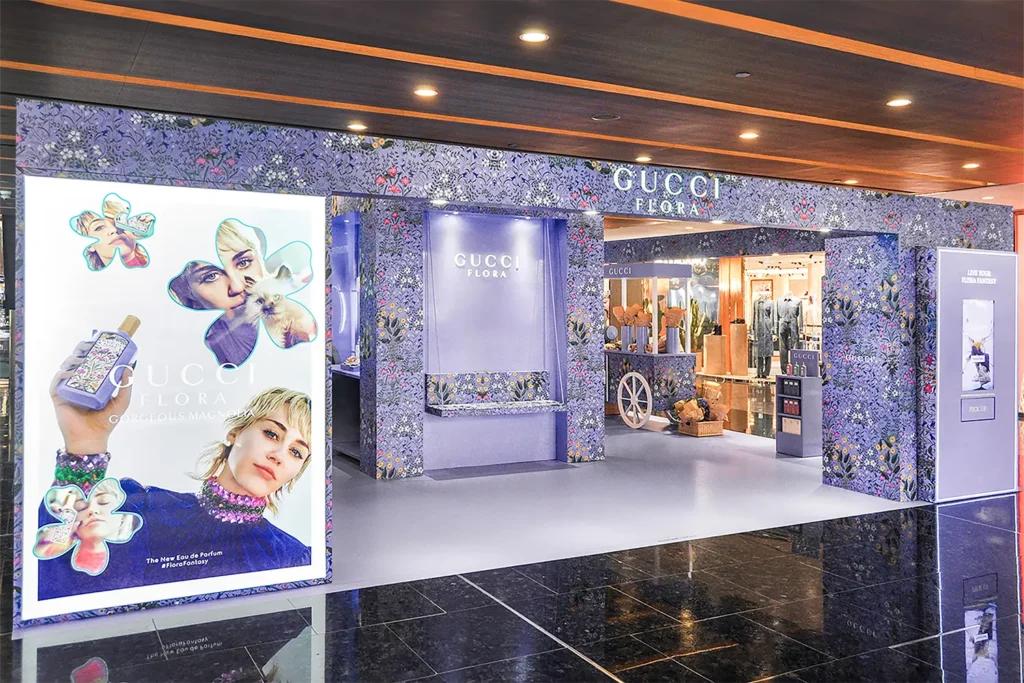
This is showcased at the Gucci Flora Gorgeous Magnolia Pop-Up, which was enveloped in a surreal flower-print interior that breathed life into the essence of the newest addition to the enchanting #FloraFantasy fragrance collection. Greeting visitors at the brand activation experience was an artful facade that housed a decorative swing — a photo opportunity that invited guests to become a part of the narrative. As visitors stepped in, meticulous design, curated spaces, and a touch of lilac-tinted magic guided them into a serene ambience away from the hustle and bustle of the shopping district. The fusion of emotion and design elevated ordinary moments into extraordinary memories, fostering connections that last.
Novelty and Surprise
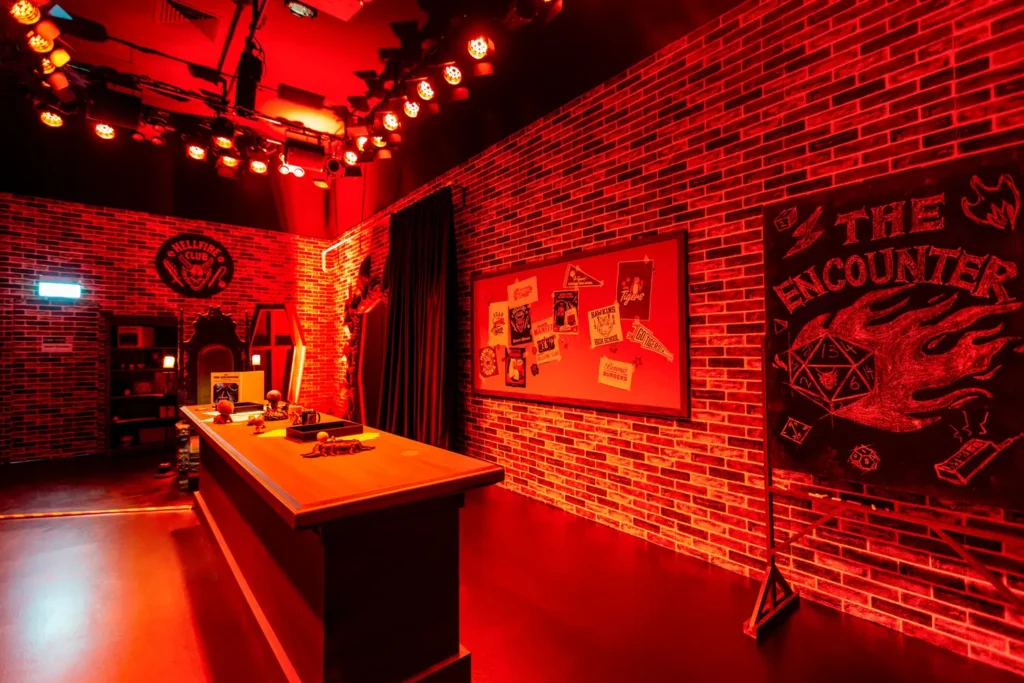
Incorporating elements of surprise can be a game-changer as it is human nature to be drawn to the novel. Unexpected twists, hidden gems, and interactive elements ignite curiosity, capturing attention in a world filled with mundane messages. The thrill of the unforeseen creates an experiential marketing narrative that is both unique and unforgettable.
Stranger Things – The Encounter: Singapore is the perfect embodiment of this concept. The immersive retail experience featured a surprise in every experiential zone, enveloping visitors in an audio-visual journey with every step. Themed sets, replicated down to the smallest detail, invited participants to step into a world they have only experienced through screens. Just when visitors thought that the adventure had run its course, the Starcourt Mall beckoned, revealing a retail and F&B haven.
Personalisation and Customisation
Crafting experiences that cater to individual preferences and needs generates a sense of exclusivity and connection. By recognising participants as individuals with distinct preferences and interests, brands can transform interactions into engaging conversations. Utilising technology to offer tailored recommendations, unique greetings, or customised content can make participants feel valued and understood. Furthermore, the fusion of interactive elements that empower participants to shape their journey cultivates engagement aligned with their interests.
Immersion and Interactivity
Immersive experiences are not purely about participating — they involve stepping into another world that engages the senses, creating a symphony of visuals, sounds, and aromas that transport visitors beyond the ordinary. For example, businesses can elevate their exhibition booths with captivating visuals that draw audiences in, curate ambient sounds that set the mood of the brand activation experience, and select alluring aromas that evoke emotions. These multi-sensory elements come together to create an experience that pulls participants into a new dimension of engagement.
But creative immersion is a two-way street. Interactive elements also play a crucial role, encouraging visitors to participate actively. Whether it is through hands-on activities, gamification, or interactive technology incorporated into a pop-up store design, these elements make participants an integral part of the experience.
2.2 Crafting the Concept and Narrative
Beyond understanding the essence of a memorable experiential marketing experience, coming up with a narrative that encapsulates the aspirations, preferences, and pain points of the target audience also forms the backbone of a resonant campaign. Here is how:
Defining the Purpose and Goals
Every experiential marketing campaign needs a purpose and goal that guides its every facet. Consider this: Is the aim to boost brand awareness, foster customer engagement, unveil a new product, or fortify brand loyalty? By pinpointing the campaign’s objectives, businesses lay the foundation for a coherent journey. This clarity empowers decision-makers to align design choices and narrative elements to achieve the desired outcomes.
Creating a Compelling Story or Theme
Step into the world of storytelling where a narrative is not a mere backdrop; it is the very spine of the experience. The journey begins with understanding the target audience — a deep dive into their demographics, preferences, dreams, and obstacles. Armed with this understanding, businesses are able to meticulously craft a narrative that intertwines with their audiences’ aspirations.
For example, by shaping the brand’s narrative and communication, businesses pave the way for harmonious and captivating visual merchandising displays that deeply resonate with customers. Consider the ways in which products or services can enhance the target audience’s lives and evoke emotions. Additionally, craft language and visuals your audience can connect with, addressing their hopes and wishes.
Learn more: The Art of Storytelling Through Visual Merchandising Displays
Establishing Cohesion and Consistency
Think about the participant’s path, from their first step into the space to their final interaction with products or exhibition booths. Each touchpoint adds to the overarching narrative, reinforcing the story you have woven. This cohesion transforms the encounter from a series of events into a complete and engaging experience.
2.3 Designing Multi-Sensory Experiences
However, in the realm of experiential marketing, the power to captivate extends beyond what meets the eye. Multi-sensory exhibition designs introduce a symphony of sensations where visuals, sounds, textures, and scents intertwine. Here are some ways to craft experiences that not only catch the eye but also form indelible memories.
Integrating Visual Elements
Vivid, mesmerising visuals command attention — every element has a purpose, be it the vibrant colours that evoke emotions, textures that beckon touch, or designs that spark curiosity. A brand’s identity and key messages can also be subtly integrated through carefully curated visuals. However, visual elements do more than just captivate; they shape the ambience of the experience. A well-chosen palette of colours sets the mood, invoking feelings of joy, excitement, or wonder. The aesthetics enhance the overall experience, enveloping participants in an atmosphere that resonates with the brand’s essence.

Take the example of the Marina Bay Sands: Christmas Décor ‘The Marina Winterscape’ which was brought to life by Dezign Format, a festive decoration company in Singapore. Handcrafted decorations adorned with shimmering lights illuminated the landscape while rows of Christmas trees sparkled with gold and silver embellishments stood tall and proud. The visual elements were a sight to behold, serving as catalysts of emotion, ambience, and lasting memories.
Incorporating Audio and Soundscapes
Sound possesses the ability to evoke feelings, awaken memories, and shape perceptions. Crafting an auditory experience is a mindful endeavour — businesses need to consider the interplay of background music, ambient sounds, and curated soundscapes. Each choice should go hand in hand with the narrative and mood of the experience. For instance, the flutter of leaves, the distant hum of a bustling city, or a gentle melody can all bring participants on an emotional journey.
Utilising Tactile and Haptic Elements
Imagine an experience where participants do not just witness but actively touch, feel, and interact with the surroundings. It is an opportunity for participants to physically immerse themselves in the encounter, transforming a conventional experience into a tactile adventure. Stimulating the sense of touch is not just about immediate engagement; it is about creating memories that last. When participants physically interact with an environment, the experience becomes tangible, leaving a more profound imprint in their memories.
Leveraging Taste and Smell
Taste and smell are the foundations of nostalgia, invoking forgotten moments and emotions long dormant. For example, the scent of a familiar perfume or the aroma of a cherished dish are like time machines that can propel us into the past. Creating an experiential marketing experience that is not only seen and heard but also tasted and smelled sets the stage for something that is immersive, emotional, and unforgettable.
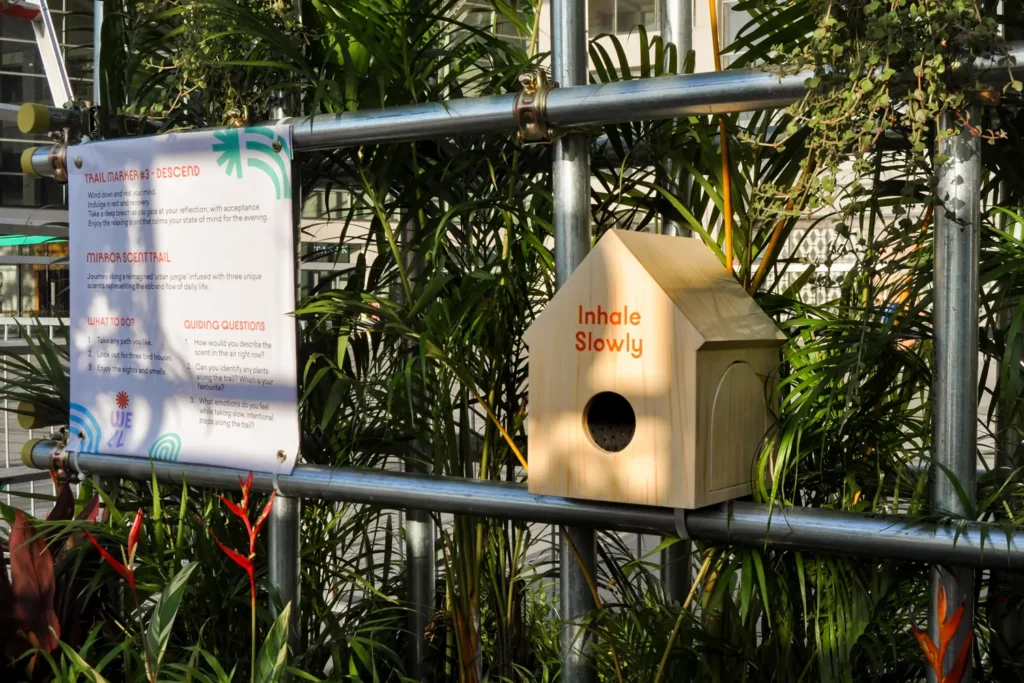
At the Wellness Festival Singapore 2023, the fusion of scent and experience was creatively showcased. Within one of the six experiential zones, delicate scent canisters resembling gable roof houses were strategically placed amidst the lush flora displays. As these canisters gently released their fragrances, the air became a canvas of scents, elevating the olfactory experience to new heights. This is a testament to how smell can transport participants into a world of sensation.
2.4 Incorporating Interactive and Participatory Elements
A successful experiential marketing campaign is also more than a passive encounter; it is an invitation for participants to step into the narrative, becoming active co-creators of the experience. These are some ways to blur the boundaries between a brand and its audience, achieving a new dimension of engagement that is vibrant, collaborative, and uniquely memorable.
Encouraging Active Participation and Engagement
When participants become active contributors to the experience, the engagement becomes personal, creating a sense of belonging. Interactive installations, challenges that ignite creativity, and activities that call for their input turn a fleeting moment into a shared memory, leaving a lasting impression that resonates with the audience long after the event concludes.
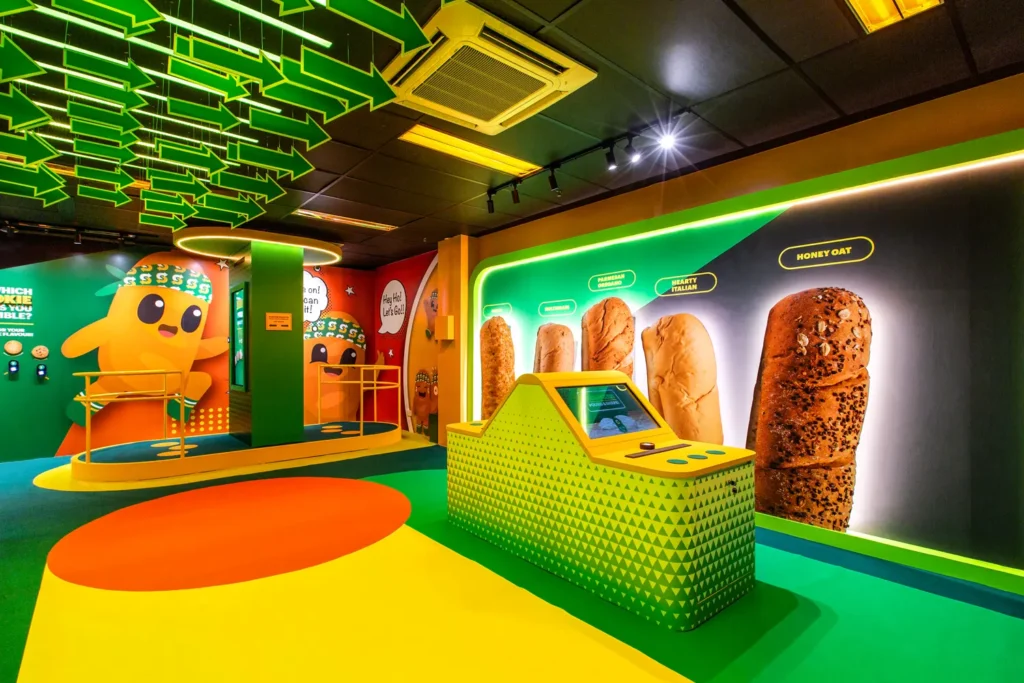
The Subway® Big Museum of Taste is a great example of successful brand activation. Its exhibition design included interactive infographic displays, bespoke 3D photo opportunities, and exterior game consoles that became the channels of engagement. These digital installations engaged participants and invited them to be part of the experience.
Incorporating Hands-on Activities, Games, or Challenges
Hands-on activities invite participants to roll up their sleeves and dive into the experience, unleashing creativity, fostering camaraderie, and immersing themselves in the moment. From physical challenges that test agility to puzzles that ignite mental prowess, experiential marketing becomes a canvas of interactive possibilities. This synergy fuels a sense of collective accomplishment that is as satisfying as it is memorable, where visitors are not just spectators but active participants.
Leveraging Technology for Interactive Experiences
Technology is the bridge between reality and possibility, breathing life into experiential marketing. Augmented reality (AR) empowers participants to superimpose digital elements onto their immediate surroundings, creating interactive landscapes that enchant them. For example, customers can try on an outfit using AR before making a purchase. On the other hand, virtual reality (VR) is a portal to entirely new dimensions, allowing participants to step into immersive digital realms. Both offer a fresh way to interact with a brand, its products, or its narratives.
Facilitating Social Sharing and User-Generated Content (UGC)
Wondering how participants can transform into your brand’s most fervent advocates? It is through the power of digital word-of-mouth — an avenue for them to share their experience with the world through the lens of their devices. A well-placed photo opportunity that entices participants to capture the moment, or unique hashtags that create a virtual gallery of shared encounters, nurtures a sense of community extending beyond the event’s physical confines.
Learn more: Ways to Build Lasting Connections With Audiences Through Immersive Experiences
2.5 The Importance of Good Spatial Design
Spatial design holds the key to unlocking the full potential of experiential marketing campaigns beyond design and the activities offered. Uncover its role in crafting experiences that resonate and captivate:
Creating a Well-Designed and Visually Appealing Physical Space
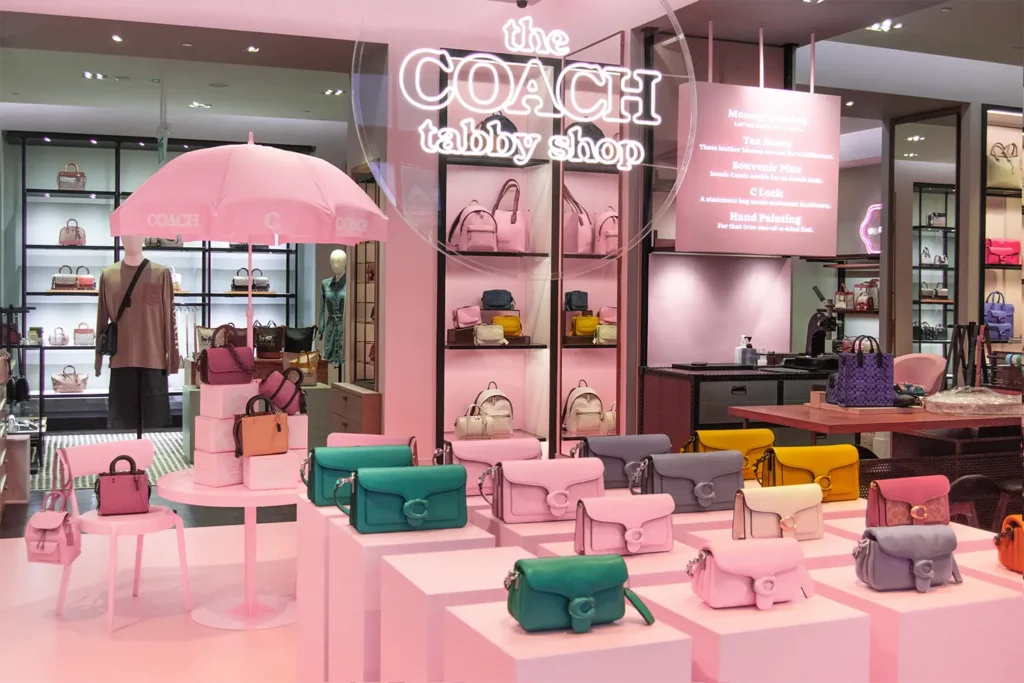
Visual appeal is a powerful tool for holding attention and creating a lasting impression. Every detail, from signage and branding to decor elements, should align seamlessly with the brand’s identity and the campaign’s theme. Through strategic placement of branding elements and decor, an environment where participants feel connected to the brand on a deeper level is created. Moreover, innovative displays, creative installations, and impactful exhibition designs transport participants into a world that ignites their imagination.
Enter the Coach Tabby Shop, where visuals were the focus. The store was enveloped in bubblegum pink and transformed into an ice cream parlour haven. From a bespoke window display to outdoor-inspired seating arrangements, every detail came together to achieve a visual feast. A playful flexi neon sign, mounted on a transparent acrylic panel, added a touch of whimsy to the modern interior aesthetics.
Optimising the Flow and Layout
Crafting a fluid and intuitive layout is important to ensure a cohesive and engaging experience. Key elements and interactive stations should be strategically positioned along the path, enhancing the narrative and facilitating engagement. Clear signage and effective wayfinding techniques are also invaluable tools in experiential marketing. They are the signposts that guide participants, ensuring they traverse the experience without hesitation. These visual cues not only offer direction but also boost immersion by providing context and anticipation. On top of that, crowd management is equally crucial. A well-managed flow of participants prevents bottlenecks and congestion, allowing every participant to enjoy the experience to its fullest.
Considering Lighting, Colours, and Spatial Arrangements
The careful selection of lighting techniques creates depth and dimension, casting a spotlight on focal points and guiding participants’ attention. Colours also possess the extraordinary ability to evoke emotions — from calming blues to vibrant reds, the palette businesses select can be a powerful storyteller. Paying attention to spatial arrangements is essential too — open spaces invite exploration, intimate nooks offer a sense of privacy, and cosy corners encourage quiet contemplation. These arrangements craft different ambiences that cater to diverse interactions.
Part 3 – Executing an Experiential Marketing Event That Leaves a Lasting Impression
3.1 Ways to Ensure a Seamless Execution
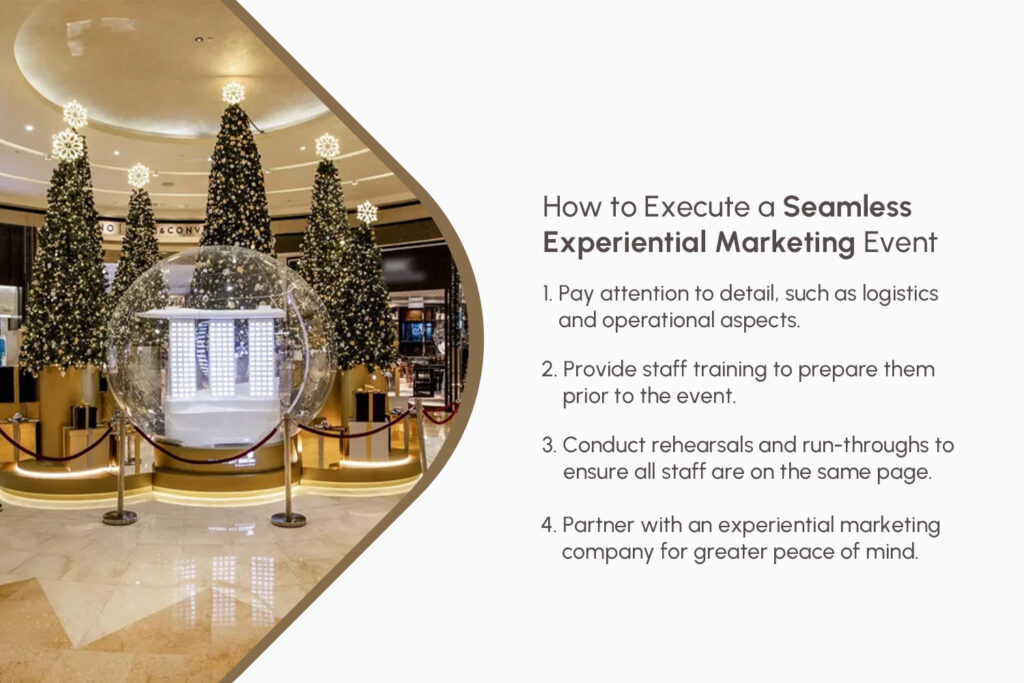
With a deeper understanding of the core elements that form the foundation of a compelling and successful experiential marketing campaign, it is now time to explore the intricacies of achieving a flawless execution of a concept.
From conception to realisation, the pursuit of a flawlessly executed experiential marketing campaign requires precision and a deep understanding of how to transform ideas into reality. Here are some ways to make the process a breeze:
Attention to Detail in Logistics and Operational Aspects
Behind the scenes, meticulous attention to logistics and operational aspects makes for a flawless experiential marketing event.
Crowd management is not just about managing heavy foot traffic; it is about crafting a seamless experiential journey. From strategically placed pathways that guide the flow to designated waiting areas that keep anticipation alive, each element should be carefully planned.
Stringent measures such as identifying emergency exits and first aid stations, and adherence to fire codes are safety nets to provide reassurance should the need arise.
In addition, the consideration of accessibility features such as ramps for wheelchairs, sensory-friendly spaces, and clear signage for those with varying abilities ensures that everyone can participate and enjoy the experience.
However, sometimes, even the most well-planned experiences can encounter unexpected twists. Regular rehearsals and scenario simulations equip event staff to handle unforeseen situations with poise and professionalism.
Staff Training and Preparation
The event staff’s attire, demeanour, and interactions are an extension of the brand’s identity. Proper training ensures that they take on their roles with pride, effectively becoming brand ambassadors who create lasting impressions.
Staff training underscores the importance of exceptional customer service, emphasising the impact of a warm smile, a helpful gesture, and a willingness to go the extra mile. These elements become part of the experience participants carry with them.
Training also prepares them to navigate the unexpected efficiently. Whether it is addressing participant inquiries, solving technical issues at exhibition booths, or unexpected scenarios, their training equips them to handle any situation that arises.
In a world where technology often takes the forefront, the human touch remains irreplaceable.
Conduct Rehearsals and Run-Throughs
Just as in any grand production, rehearsals and run-throughs play an important role in executing an impeccable experiential marketing campaign.
Rehearsals are an opportunity to fine-tune every aspect, from the interactive installations to the lighting cues. Run-throughs serve as a testing ground to unmask potential issues. Are the digital displays functioning properly? Are the interactive stations responding as they should? By identifying and addressing these glitches during rehearsals, the actual experience can be free of interruptions.
Collaborate With an Experiential Marketing Company
Partnering with an experiential marketing company means having greater peace of mind. These professionals have a repertoire of successful campaigns under their belts, bringing a wealth of experience to the table. They understand the nuances of crafting immersive narratives, choosing the right elements, and curating seamless experiences that engage participants on a profound level.
Collaborating with these experts also opens the door to fresh perspectives and imaginative ideas that might have remained undiscovered otherwise.
The best part of it all is that they possess an extensive network of trusted vendors, cutting-edge technology solutions, and insights into industry best practices that ensure a smooth journey.
Learn more: Qualities and Expertise to Look for in a Design and Build Company
3.2 Measuring Success and Feedback
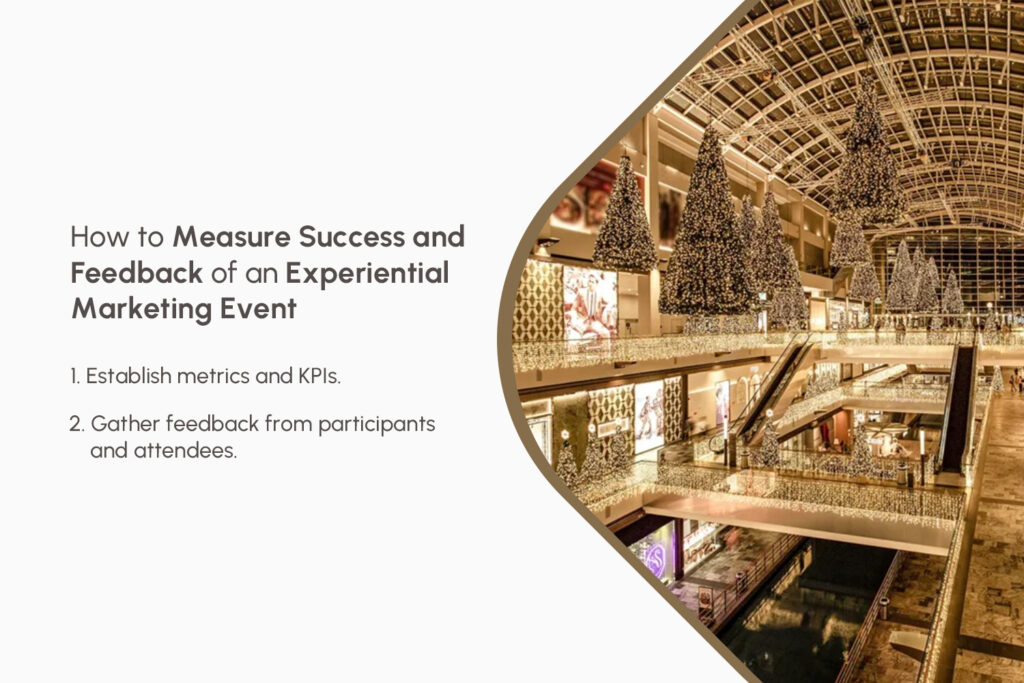
The journey of a successful experiential marketing campaign does not just stop once the event is over. In fact, that is when a crucial phase begins: measuring success and gathering feedback.
Establishing Metrics and Key Performance Indicators (KPIs)
Whether it is tracking the number of attendees, the levels of engagement, or the conversions generated, these metrics provide concrete data to evaluate the campaign’s success against the predefined goals. They provide objective insights into the effectiveness of the experiential marketing efforts, offering a clear picture of whether the campaign resonated with the audience and achieved its intended outcomes, free from subjective biases.
Collecting Feedback from Participants and Attendees
The campaign’s success can be measured not just in numbers but also in the insights gathered from those who experienced it. By gathering feedback from the attendees, businesses gain a clear understanding of what worked, what resonated, and what might need improvement in the future. Participant feedback can also reveal unexpected aspects of the experience that garnered positive responses — it might be a particular interactive element, a sensory touchpoint, or an emotional connection.
Similarly, participant feedback identifies areas that could be improved in the experiential marketing campaign. Whether it is streamlining navigation, boosting engagement, or amplifying emotional connections, feedback guides businesses’ efforts toward enhancing future experiences.
3.3 Answering Frequently Asked Questions About Experiential Marketing
Navigating the realm of experiential marketing can sometimes be challenging. As businesses strive to create memorable connections with their audiences, questions naturally arise. Here are some frequently asked questions answered to provide greater clarity:
Why is experiential marketing important?
Experiential marketing is important because it is a refreshing alternative to traditional marketing that creates a lasting impression on consumers. It allows brands to craft meaningful interactions, build emotional connections, and generate positive word-of-mouth marketing.
What are the benefits of experiential marketing?
Experiential marketing allows brands to create personal and emotional connections with their audiences, increasing brand loyalty and advocacy. It provides an opportunity to showcase products or services in a tangible and interactive way, driving sales and conversions. Additionally, experiential marketing often generates social media buzz and user-generated content, extending the reach and impact of the campaign.
What are some examples of experiential marketing campaigns?
Successful experiential marketing campaigns include a wide range of strategies and approaches. Examples include pop-up events, interactive installations, branded experiences at festivals or trade shows, immersive storytelling, product demonstrations, or collaborative activities that involve the audience.
From Moments to Memories: The Experiential Marketing Approach
Experiential marketing stands as a transformative force in the ever-evolving landscape of consumer engagement. Its ability to forge emotional connections, create indelible memories, and spark authentic interactions sets it apart from traditional marketing methods.
As you embark on your experiential marketing journey, consider partnering with Dezign Format, an exhibition and design and build company in Singapore. With our expertise, your brand’s vision becomes reality.
We specialise in creating immersive and impactful experiences that captivate, inspire, and leave an enduring imprint on your audience’s hearts and minds. Embrace the world of experiential marketing and let Dezign Format guide you toward crafting moments that truly matter.



